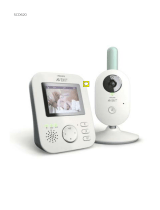
- Never immerse any part of the baby monitor in water or any other liquid.
- Check if the voltage indicated on the adapters of the baby unit and the parent unit corresponds
to the local mains voltage before you connect the appliance.
- Only use the adapters supplied to connect the baby unit and the parent unit to the mains.
- The adapters contain a transformer. Do not cut off the adapters to replace them with other
plugs, as this causes a hazardous situation.
- If the adapters are damaged, always have them replaced with one of the original type in order
to avoid a hazard. For the correct type, see chapter ‘Replacement’.
- Never use the baby monitor in moist places or close to water.
- Except for the battery compartments, do not open the housing of the baby unit and parent unit
in order to prevent electric shock.
- This appliance is not intended for use by persons (including children) with reduced physical,
sensory or mental capabilities, or lack of experience and knowledge, unless they have been given
supervision or instruction concerning use of the appliance by a person responsible for their
safety.
- Children should be supervised to ensure that they do not play with the appliance.
- Use and store the appliance at a temperature between 10°C and 35°C.
- Do not expose the baby unit and parent unit to extreme cold or heat or to direct sunlight. Do
not put the baby unit and the parent unit close to a heating source.
- Make sure the baby unit and the cord are always out of reach of the baby (at least 1 metre/3
feet away).
- Never place the baby unit inside or mount it on the baby’s bed or playpen.
- Never cover the parent unit and the baby unit with anything (e.g. a towel or blanket).
- This baby monitor is intended as an aid. It is not a substitute for responsible and proper adult
supervision and should not be used as such.
- The operating range of the baby monitor is 150 metres/490 feet in open air. Depending on the
surroundings and other disturbing factors, this range may be smaller.
- If you have any combination of cordless phones, wireless video, Wi-Fi networks, microwave or
Bluetooth on 2.4Ghz, connection problems may occur. The connection between the parent unit
and the baby unit could be lost for some seconds or may cause interference with other devices.
- We advise you to use the parent unit connected to the mains to save energy. The baby video
monitor consumes more energy than a standard baby monitor (without video).
- Always place a rechargeable battery of the correct type in the parent unit. Do not use non-
rechargeable batteries to avoid the risk of explosion.
- Always place non-recheargeable batteries of the correct type in the baby unit. The baby unit
does not have a charging function.
- Make sure that your hands are dry when you insert or replace the batteries.
- To avoiding damage due to battery leakage:
Do not expose the appliance to temperatures higher than 35°C.
Remove the rechargeable battery and the non-rechargeable batteries if you are not going
to use the appliance for one month or more.
Do not leave empty batteries in the baby unit.
7
















